Neutron Diffraction Measurements of Residual Stresses for Ferritic Steel Specimens over 80 mm Thick
Abstract
:1. Introduction
2. Experimental Procedure
3. Results and Discussion
3.1. Optimum Beam Properties for (112) and (220) Diffractions in Ferritic Steels
3.2. Strain Error Measurements as a Function of the Penetration Depth
3.3. Reasons for the Lower Strain Errors with the (220) Diffraction
4. Conclusions
Author Contributions
Funding
Data Availability Statement
Acknowledgments
Conflicts of Interest
References
- Withers, P.J.; Bhadeshia, H.K.D.H. Overview residual stress, part 2: Nature and origin. Mater. Sci. Technol. 2001, 17, 366–375. [Google Scholar] [CrossRef]
- Hutchings, M.T.; Withers, P.J.; Holden, T.M.; Lorentzen, T. Introduction to the Characterization of Residual Stress by Neutron Diffraction; Taylor and Francis: London, UK, 2005. [Google Scholar]
- Santistaban, J.R.; Daymond, M.R.; James, J.A.; Edvards, L. ENGIN-X: A third-generation neutron strain scanner. J. Appl. Cryst. 2006, 39, 812–825. [Google Scholar] [CrossRef]
- Smith, D.J.; Bouchard, P.J.; George, D. Measurement andprediction of residual stresses in thick-section steel welds. J. Strain Anal. 2000, 35, 287–305. [Google Scholar] [CrossRef]
- Rossini, N.S.; Dassisti, M.; Benyounis, K.Y.; Olabi, A.G. Review: Methods of measuring residual stress in components. Mater. Des. 2012, 35, 572–588. [Google Scholar] [CrossRef]
- Dive, V.; Lakade, S. Recent Research Progress on Residual Stress Measurement Using Non-Destructive Testing. Mater. Today Proc. 2021, 47, 3282–3287. [Google Scholar] [CrossRef]
- Withers, P.J. Depth capabilities of neutron and synchrotron diffraction strain measurement instruments, I. The maximum feasible path length. J. Appl. Cryst. 2004, 37, 596–606. [Google Scholar] [CrossRef]
- Withers, P.J. Depth capabilities of neutron and synchrotron diffraction strain measurement instruments, II. Practical implications. J. Appl. Cryst. 2004, 37, 607–612. [Google Scholar] [CrossRef]
- Woo, W.; Em, V.; Seong, B.S.; Shin, E.; Mikula, P.; Joo, J.; Kang, M. Effect of wavelentgh-dependent attenuation on neutron diffraction stress measurerments at depth in steel. J. Appl. Cryst. 2011, 44, 747–754. [Google Scholar] [CrossRef]
- Lodh, A.; Thool, K.; Samajdar, I. X-ray Diffraction for the Determination of Residual Stress of Crystalline Material: An Overview. Trans. Indian Inst. Met. 2022, 75, 983–995. [Google Scholar] [CrossRef]
- Woo, W.; An, G.B.; Kingston, E.J.; DeWald, A.T.; Smith, D.J.; Hill, M.R. Through-thickness distributions of residual stresses in two extreme heat-input thick welds: A neutron diffraction, contour method and deep hole drilling study. Acta Mater. 2013, 61, 3564–3574. [Google Scholar] [CrossRef]
- Woo, W.; An, G.B.; Em, V.T.; DeWald, A.T.; Hill, M.R. Through-thickness distributions of residual stresses in an 80 mm thick weld using neutron diffraction and contour method. J. Mater. Sci. 2015, 50, 784–793. [Google Scholar] [CrossRef]
- Jiang, W.; Li, J.; Wan, Y.; Sun, G.; Tu, S.-Y.; Woo, W. Determination of the through-thickness residual stress in thick duplex stainless steel welded plate by wavelength-dependent neutron diffraction method. Int. J. Press. Vessel. Pip. 2022, 196, 104603. [Google Scholar] [CrossRef]
- Popovici, M.; Yelon, W.B.; Berliner, R.; Stoica, A.D.; Ionita, I.; Law, R. Curved crystal optics and the resolution formalism: Programs and optimization procedures. Nucl. Instrum. Methods Phys. Res. Sect. A 1994, 338, 99–110. [Google Scholar] [CrossRef]
- Schröder, J.; Evans, A.; Mishurova, T.; Ulbricht, A.; Sprengel, M.; Serrano-Munoz, I.; Fritsch, T.; Kromm, A.; Kannengießer, T.; Bruno, G. Diffraction-Based Residual Stress Characterization in Laser Additive Manufacturing of Metal. Metals 2021, 11, 1830. [Google Scholar] [CrossRef]
- Popovici, M.; Stoica, A.D. Neutron imaging with multi-wafer monochromators. Appl. Phys. A 2002, 74, S273–S276. [Google Scholar] [CrossRef]
- Moon, M.-K.; Em, V.T.; Lee, C.-H.; Mikula, P.; Hong, K.-P.; Choi, Y.-H.; Cheon, J.-K.; Nam, U.-W.; Kong, K.-N.; Jin, K.-C. Optimization of bent perfect Si(2 2 0) crystal monochromator for residual strain/stress instrument. Part II. Phys. B Condens. Matter 2005, 368, 70–75. [Google Scholar] [CrossRef]
- Mohamed, O.; Zhu, B.; Leung, N.; Kockelmann, W.; Barrett, T.R.; Whiting, M.J.; Wang, Y.; Sui, T. The use of time-of-flight neutron Bragg edge imaging to measure the residual strains in W/Cu dissimilar joints for fusion reactors. Nucl. Mater. Energy 2024, 38, 101593. [Google Scholar] [CrossRef]
- Bunn, J.R.; Fancher, C.M.; Payzant, E.A.; Cornwell, P.A.; Bailey, W.B.; Gregory, R. The high intensity diffractometer for residual stress analysis (HIDRA), a third generation residual stress mapping neutron diffractometer at the high flux isotope reactor. Rev. Sci. Instrum. 2023, 94, 035101. [Google Scholar] [CrossRef] [PubMed]
- Hao, J.; Tan, Z.; Lu, H.; Deng, S.; Shen, F.; Zhao, D.; Zheng, H.; Ma, Q.; Chen, J.; He, L. Residual stress measurement system of the general purpose powder diffractometer at CSNS. Nucl. Inst. Methods Phys. Res. A 2023, 1055, 168532. [Google Scholar] [CrossRef]
- Withers, P.J.; Daymond, M.R.; Johnson, M.W. The precision of diffraction peak location. J. Appl. Cryst. 2001, 34, 737–743. [Google Scholar] [CrossRef]
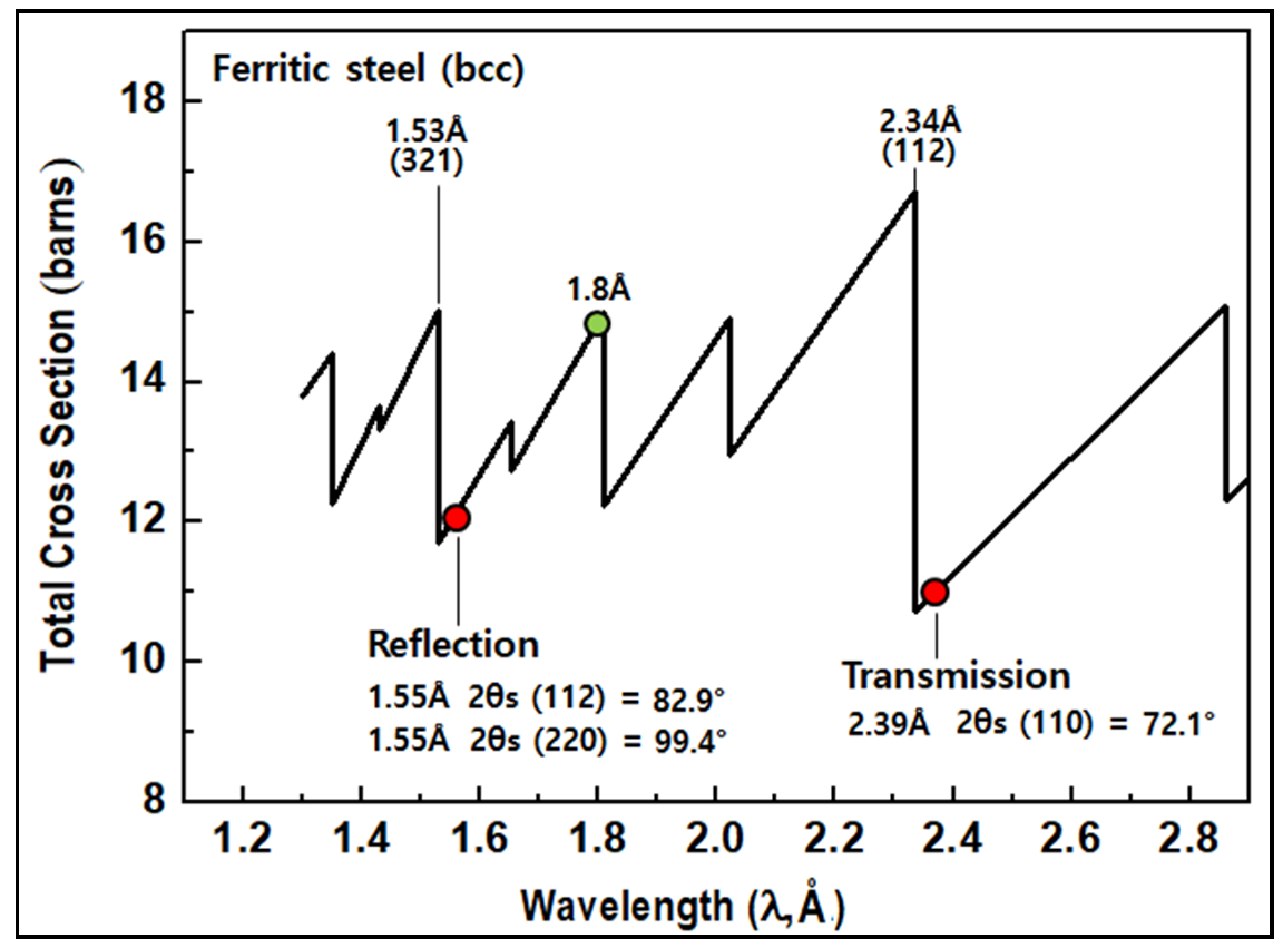

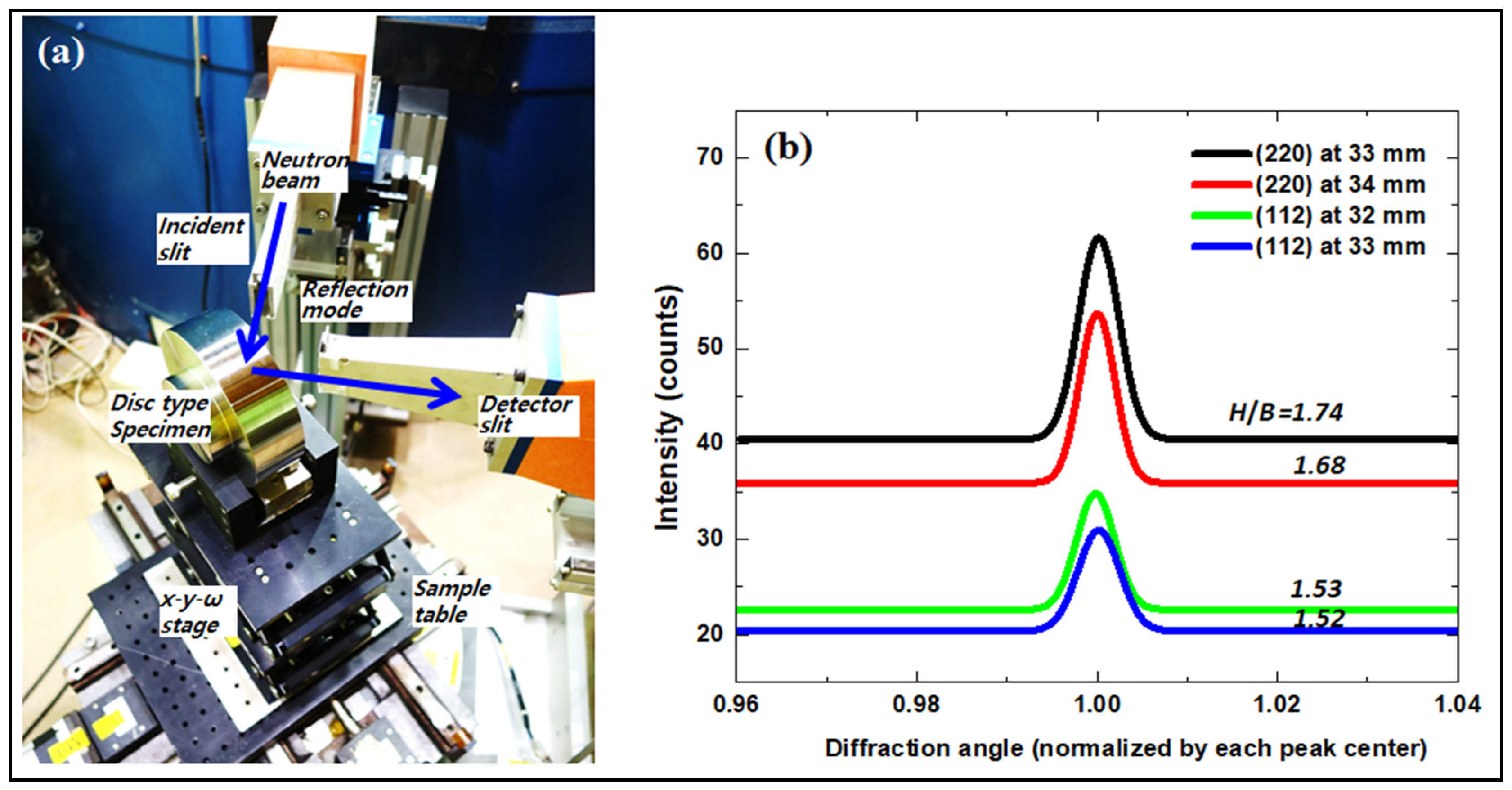
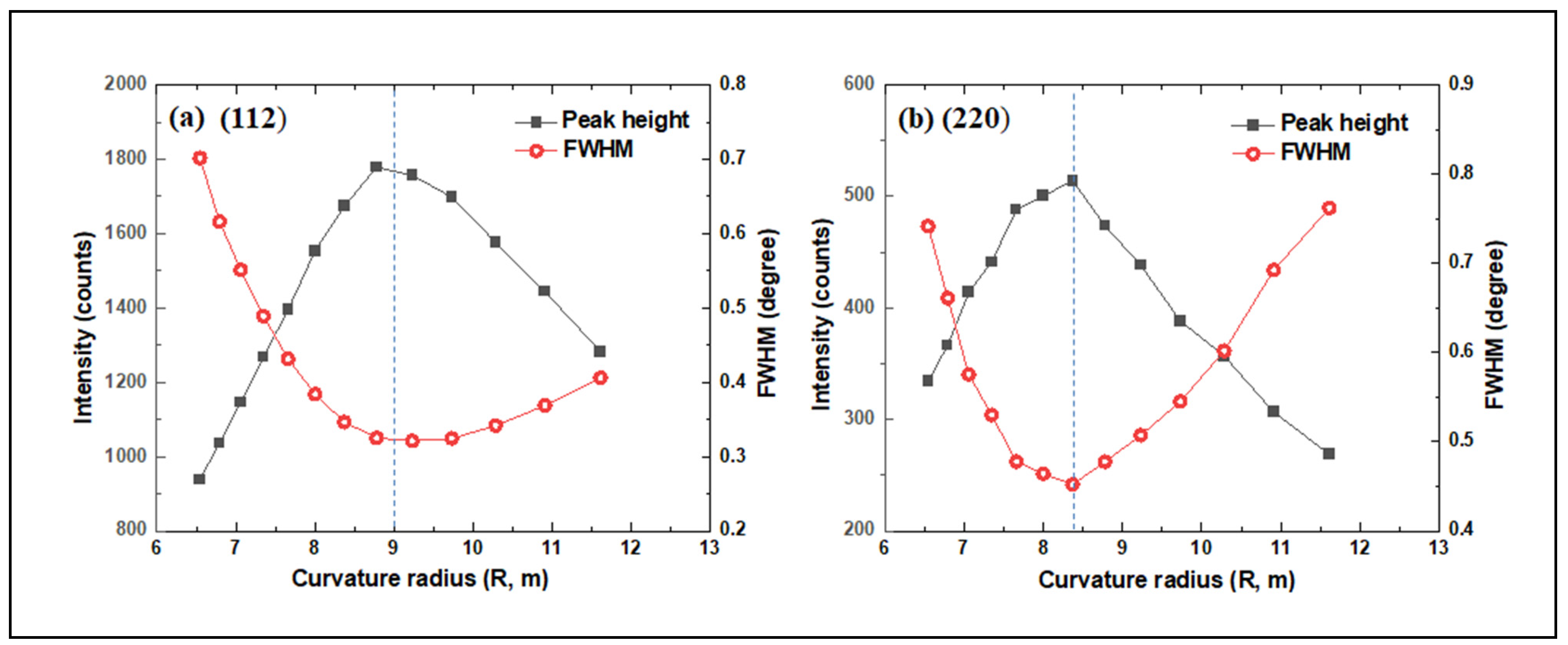
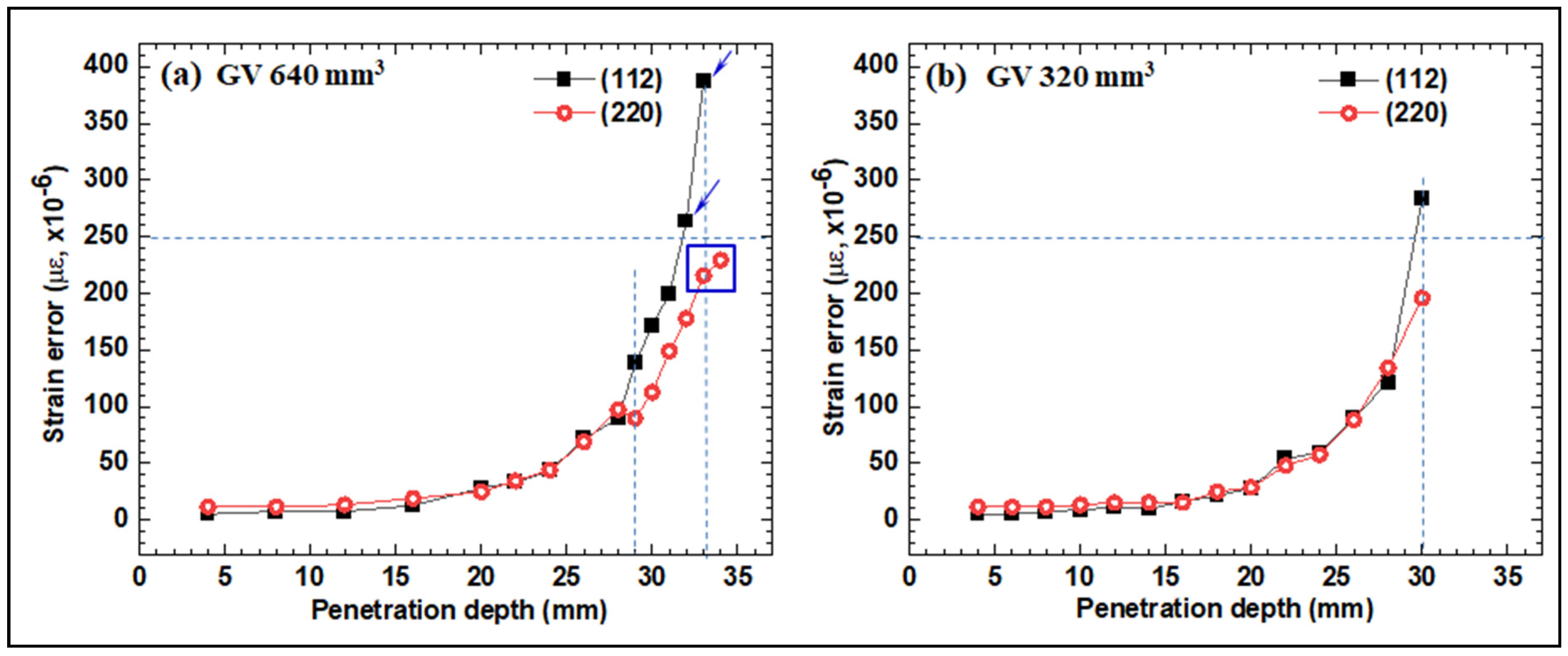

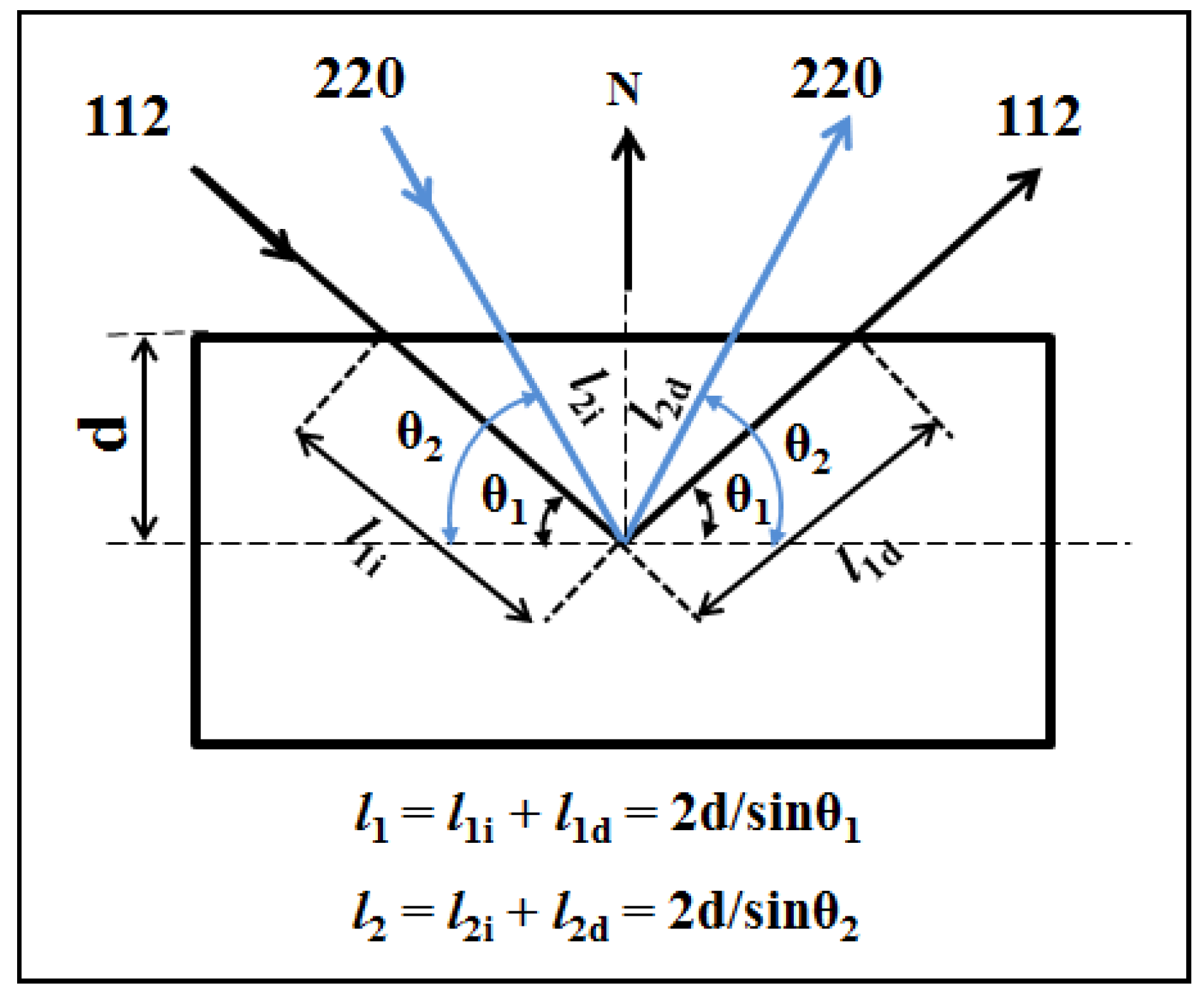
| Configuration | Monochromator | 2θM (deg) | λ (Å) | Diffraction Plane | Diffraction Angle (2θ, deg) |
|---|---|---|---|---|---|
| 1 | Si (111) | 45 | 2.39 | (110) | 72.1 |
| 2 | Si (220) | 48 | 1.55 | (112) | 82.9 |
| 3 | Si (220) | 48 | 1.55 | (220) | 99.4 |
Disclaimer/Publisher’s Note: The statements, opinions and data contained in all publications are solely those of the individual author(s) and contributor(s) and not of MDPI and/or the editor(s). MDPI and/or the editor(s) disclaim responsibility for any injury to people or property resulting from any ideas, methods, instructions or products referred to in the content. |
© 2024 by the authors. Licensee MDPI, Basel, Switzerland. This article is an open access article distributed under the terms and conditions of the Creative Commons Attribution (CC BY) license (https://creativecommons.org/licenses/by/4.0/).
Share and Cite
Em, V.; Ivan, K.; Woo, W.; Mikula, P. Neutron Diffraction Measurements of Residual Stresses for Ferritic Steel Specimens over 80 mm Thick. Metals 2024, 14, 638. https://doi.org/10.3390/met14060638
Em V, Ivan K, Woo W, Mikula P. Neutron Diffraction Measurements of Residual Stresses for Ferritic Steel Specimens over 80 mm Thick. Metals. 2024; 14(6):638. https://doi.org/10.3390/met14060638
Chicago/Turabian StyleEm, Vyacheslav, Karpov Ivan, Wanchuck Woo, and Pavol Mikula. 2024. "Neutron Diffraction Measurements of Residual Stresses for Ferritic Steel Specimens over 80 mm Thick" Metals 14, no. 6: 638. https://doi.org/10.3390/met14060638





